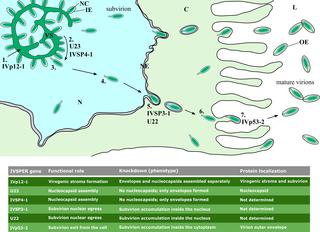当前位置:
X-MOL 学术
›
PLOS Pathog.
›
论文详情
Our official English website, www.x-mol.net, welcomes your feedback! (Note: you will need to create a separate account there.)
RNA interference identifies domesticated viral genes involved in assembly and trafficking of virus-derived particles in ichneumonid wasps.
PLoS Pathogens ( IF 6.7 ) Pub Date : 2019-12-13 , DOI: 10.1371/journal.ppat.1008210 Ange Lorenzi 1 , Marc Ravallec 1 , Magali Eychenne 1 , Véronique Jouan 1 , Stéphanie Robin 2, 3 , Isabelle Darboux 1 , Fabrice Legeai 2, 3 , Anne-Sophie Gosselin-Grenet 1 , Mathieu Sicard 4 , Don Stoltz 5 , Anne-Nathalie Volkoff 1
PLoS Pathogens ( IF 6.7 ) Pub Date : 2019-12-13 , DOI: 10.1371/journal.ppat.1008210 Ange Lorenzi 1 , Marc Ravallec 1 , Magali Eychenne 1 , Véronique Jouan 1 , Stéphanie Robin 2, 3 , Isabelle Darboux 1 , Fabrice Legeai 2, 3 , Anne-Sophie Gosselin-Grenet 1 , Mathieu Sicard 4 , Don Stoltz 5 , Anne-Nathalie Volkoff 1
Affiliation

|
There are many documented examples of viral genes retained in the genomes of multicellular organisms that may in some cases bring new beneficial functions to the receivers. The ability of certain ichneumonid parasitic wasps to produce virus-derived particles, the so-called ichnoviruses (IVs), not only results from the capture and domestication of single viral genes but of almost entire ancestral virus genome(s). Indeed, following integration into wasp chromosomal DNA, the putative and still undetermined IV ancestor(s) evolved into encoding a 'virulence gene delivery vehicle' that is now required for successful infestation of wasp hosts. Several putative viral genes, which are clustered in distinct regions of wasp genomes referred to as IVSPERs (Ichnovirus Structural Protein Encoding Regions), have been assumed to be involved in virus-derived particles morphogenesis, but this question has not been previously functionally addressed. In the present study, we have successfully combined RNA interference and transmission electron microscopy to specifically identify IVSPER genes that are responsible for the morphogenesis and trafficking of the virus-derived particles in ovarian cells of the ichneumonid wasp Hyposoter didymator. We suggest that ancestral viral genes retained within the genomes of certain ichneumonid parasitoids possess conserved functions which were domesticated for the purpose of assembling viral vectors for the delivery of virulence genes to parasitized host animals.
中文翻译:

RNA干扰可识别参与鱼鳞龙黄蜂中病毒来源颗粒的组装和贩运的驯化病毒基因。
有许多文献记载的多细胞生物基因组中保留的病毒基因实例,在某些情况下可能为受体带来新的有益功能。某些鱼腥藻寄生性黄蜂产生病毒衍生颗粒的能力,即所谓的鱼鳞病毒(IVs),不仅是由于单个病毒基因的捕获和驯化而导致的,而且几乎是整个祖传病毒基因组的捕获和驯化的结果。确实,在整合入黄蜂染色体DNA之后,推定且仍未确定的IV祖先演变为编码“毒力基因传递载体”,而如今,成功感染黄蜂宿主需要使用这种“毒力基因传递载体”。几个推定的病毒基因,它们聚集在黄蜂基因组的不同区域,称为IVSPER(线粒体病毒结构蛋白编码区),假定已参与病毒衍生颗粒的形态发生,但以前尚未在功能上解决此问题。在本研究中,我们已经成功地将RNA干扰和透射电子显微镜相结合,以特异性鉴定IVSPER基因,该基因负责鱼龙脑类黄蜂Hyposoter双向标记子的卵巢细胞中病毒衍生颗粒的形态发生和运输。我们建议保留在某些鱼腥藻类寄生生物的基因组中的祖先病毒基因具有保守的功能,这些功能被驯化,目的是为了组装病毒载体以将毒力基因传递给被寄生的宿主动物。我们已经成功地将RNA干扰和透射电子显微镜相结合,以特异性鉴定IVSPER基因,这些基因负责鱼鳞龙类黄蜂Hyposoter双向标记物的卵巢细胞中病毒衍生颗粒的形态发生和运输。我们建议保留在某些鱼腥藻类寄生生物的基因组中的祖先病毒基因具有保守的功能,这些功能被驯化,目的是为了组装病毒载体以将毒力基因传递给被寄生的宿主动物。我们已经成功地结合了RNA干扰和透射电子显微镜技术,以特异性鉴定IVSPER基因,这些基因负责鱼鳞龙类黄蜂Hyposoter双向标记子卵巢细胞中病毒衍生颗粒的形态发生和运输。我们建议保留在某些鱼腥藻类寄生生物的基因组中的祖先病毒基因具有保守的功能,这些功能被驯化,目的是为了组装病毒载体以将毒力基因传递给被寄生的宿主动物。
更新日期:2019-12-17
中文翻译:

RNA干扰可识别参与鱼鳞龙黄蜂中病毒来源颗粒的组装和贩运的驯化病毒基因。
有许多文献记载的多细胞生物基因组中保留的病毒基因实例,在某些情况下可能为受体带来新的有益功能。某些鱼腥藻寄生性黄蜂产生病毒衍生颗粒的能力,即所谓的鱼鳞病毒(IVs),不仅是由于单个病毒基因的捕获和驯化而导致的,而且几乎是整个祖传病毒基因组的捕获和驯化的结果。确实,在整合入黄蜂染色体DNA之后,推定且仍未确定的IV祖先演变为编码“毒力基因传递载体”,而如今,成功感染黄蜂宿主需要使用这种“毒力基因传递载体”。几个推定的病毒基因,它们聚集在黄蜂基因组的不同区域,称为IVSPER(线粒体病毒结构蛋白编码区),假定已参与病毒衍生颗粒的形态发生,但以前尚未在功能上解决此问题。在本研究中,我们已经成功地将RNA干扰和透射电子显微镜相结合,以特异性鉴定IVSPER基因,该基因负责鱼龙脑类黄蜂Hyposoter双向标记子的卵巢细胞中病毒衍生颗粒的形态发生和运输。我们建议保留在某些鱼腥藻类寄生生物的基因组中的祖先病毒基因具有保守的功能,这些功能被驯化,目的是为了组装病毒载体以将毒力基因传递给被寄生的宿主动物。我们已经成功地将RNA干扰和透射电子显微镜相结合,以特异性鉴定IVSPER基因,这些基因负责鱼鳞龙类黄蜂Hyposoter双向标记物的卵巢细胞中病毒衍生颗粒的形态发生和运输。我们建议保留在某些鱼腥藻类寄生生物的基因组中的祖先病毒基因具有保守的功能,这些功能被驯化,目的是为了组装病毒载体以将毒力基因传递给被寄生的宿主动物。我们已经成功地结合了RNA干扰和透射电子显微镜技术,以特异性鉴定IVSPER基因,这些基因负责鱼鳞龙类黄蜂Hyposoter双向标记子卵巢细胞中病毒衍生颗粒的形态发生和运输。我们建议保留在某些鱼腥藻类寄生生物的基因组中的祖先病毒基因具有保守的功能,这些功能被驯化,目的是为了组装病毒载体以将毒力基因传递给被寄生的宿主动物。



























 京公网安备 11010802027423号
京公网安备 11010802027423号